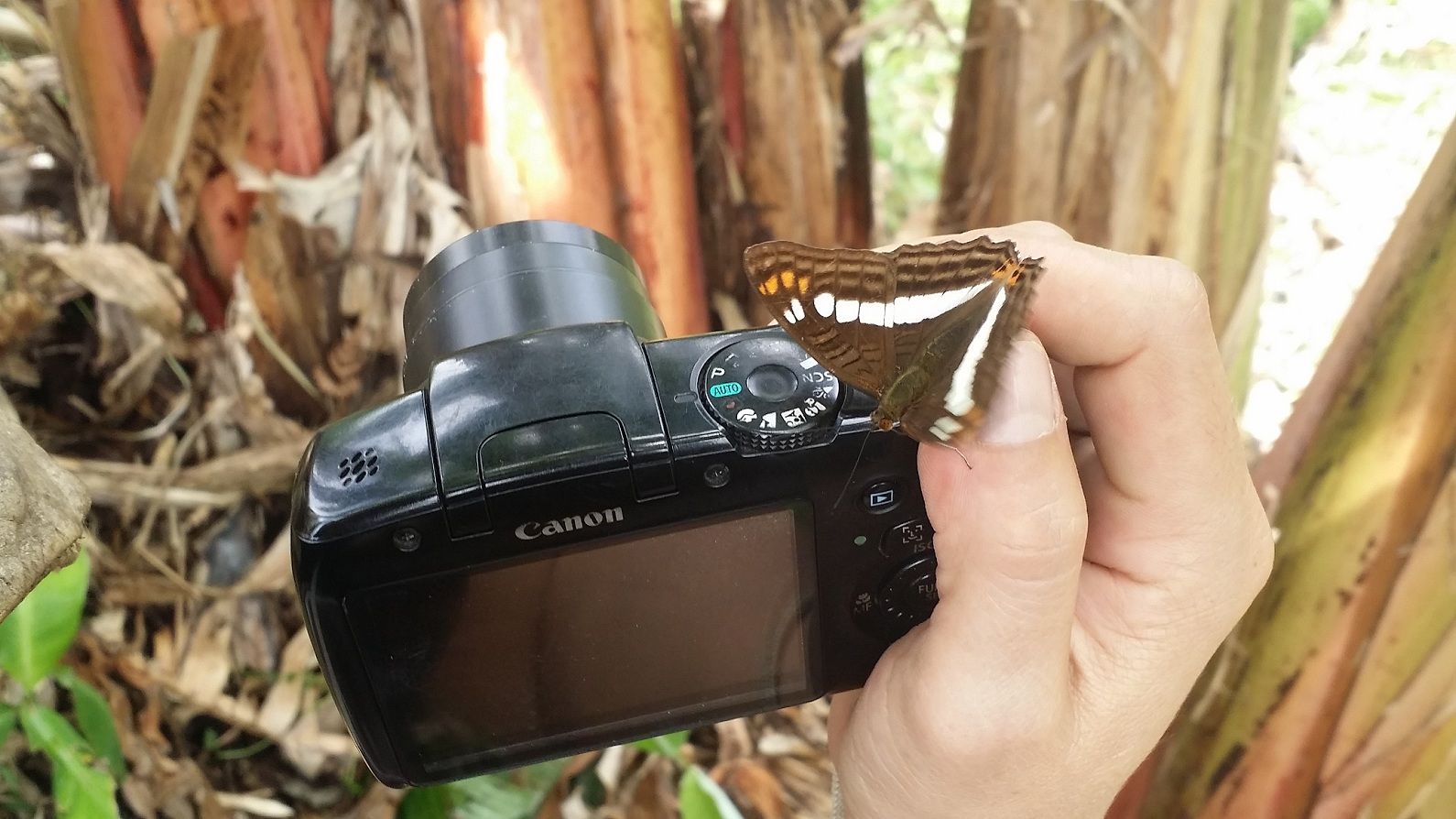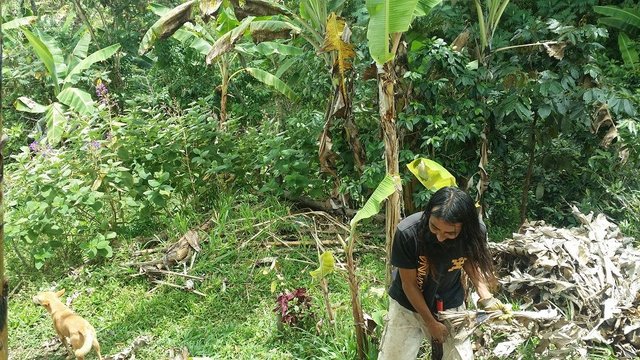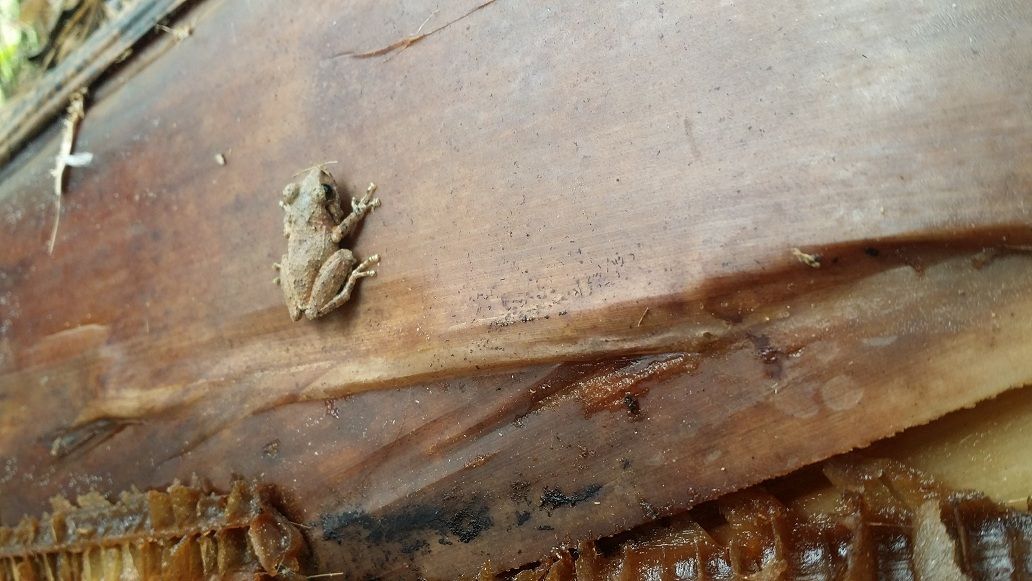Cleaning the giant banana plant and eating the ugly frog first
I was so inspired by @themarkymark ‘s article and subsequent encouragement, that this morning we rushed out hunting ugly frogs to eat.
For those of you not familiar, Brian Tracey apparently wrote in a book that if you have to eat two frogs, you should eat the ugly one first. Eating frogs symbolizing unappealing tasks, if we conquer the ugliest and least pleasant task first, its smooth sailing from there, hopeful even achieving the legendary state of flow.
Here is our first ugly frog! This massive banana plant is difficult to deal with because of its trunks’ size, weight and girth. For nearly 2 years we have procrastinated a good cleaning for this particular plant. We clean the dead leaves and old stumps out of banana and plantain groups 2 to 3 times a year, so this particular plant has been skipped for the last 5 or 6 cleanings.
It has been skipped because we have been violating the principle of the ugly frog! If we save the ugliest frog for last, we can easily loose motivation, energy and focus instead of finishing strong.
We mustered together, with my wife Ledis and our groundskeeper José, collected our tools and prepared to conquer the ugliest frog among banana plants. We are using sharpened square shovels, machetes and a media luna, a sharp crescent shaped piece of metal mounted on a long piece of bamboo.
As the bananas grow they send out more and more long palm-like leaves, and long dry dead leaves tell the story of banana or plantain maintenance, the more leaves the longer it has been!
If the leaves are cut before they turn fully brown, they are a treat for horses! This particular banana group is located on a corner of our horse paddock, so we were quickly joined by our mare Umi and her son Valentín.
The first task was to clean the dead and dying leaves from all around the different banana trunks. We start from the outside first, and work our way all the way around.
We were joined by another member of the team, our Rooster who came to help scratch and peck.
We only have one crescent leaf cutter, so while José uses it to get the highest of the dead leaves, I use a sharpened square shovel to cut the leaves at medium height.
Diligently, our horses continue to do their part.
Luckily this giant banana grouping has two bunches that are ready for cutting. We will leave that job for last, but we are happy to see that this ugly frog bears fruit!
I work my way to the inside, cleaning the low and medium height dead and dying leaves while Ledis continues to take pictures and direct her shots, moving between several favored vantage points to take pictures for this article.
I encounter the first of many rotting banana trunks, these are trunks that were either cut high to harvest the fruit or left to attract and observe local birds, and have slowly decomposed anaerobically as the sloppy wet banana trunks putrefy. The heavy smell of putrification and fermented banana trunk juices have made this an ugly frog for as long as we haven’t cleaned it.
After a few chops with my square shovel, I try to leverage a dead trunk out of the circle.
I’m unable to immediately free this banana trunk, but we have broken inside. I continue to chop away at the hard nucleus of the trunk where it meets the earth as I stand on the spongy mummified remains of banana trunks dating back to the origin of this corm, perhaps years before we arrived.
With my shovel I take wedges out of any trunk I want to remove and then try to use the leverage of the trunk to separate it from the earth.
This particular trunk will remain stubborn for a while longer, but we continue to make progress. There are many older trunks in the inner ring, and we slowly work our way around.
These dead trunks are also ‘clogging’ the corm, choking out future generations of banana trunks. This incredibly important maintenance program will result in more and better bananas in the long run!
The long fibrous leaves of the banana plant have an incredibly resistant natural fiber at their heart. These stalks will be stripped of leaves and used to make a basket! Hopefully we will see a future article about that.
Nube the sheep has come over to help us as well. Sheep will eat the banana leaves even when they are dry and brown. She also likes to help with grasses in the area.
I finally gain enough leverage over a banana trunk to be able to take it out completely, roots and all. Using my entire body weight one finally comes out.
The complete corm, when removed, will sprout new banana trunks and try to root. It’s best to dig a shallow pit and roll the old corm in, this way the new banana trunks will have a deeper center of gravity and won’t easily blow over in the wind.
We continue to clean and cut all the dry material from around the banana group.
And as we are doing that, we come across a nest! An Icterus chrysater nest, a beautiful yellow-backed oriole that we included in our Líbano welcome sign has been living in our banana bunch! The nest was successfully used to hatch an unknown number of babies.
More friends come to visit when a butterfly charges into the shots and assaults the photographer!
We all quickly make friends.
José and I continue removing old trunks and stacking them downhill. These will gradually dry out and compost like all other organic matter. Our giant bananas produce a lot of biomass, but they also contain incredible quantities of water, and their generally wetter centers are slow to dry out unless they are finely chopped up. Today we opt to chop them into medium sized pieces and focus on cleaning the group of bananas.
The butterfly continues to accompany us, even to the point of distraction!

We move the dry leaves to the side, and clear a space for the trunks to decompose. We are using an area I call ‘The Bluff’, which is actually a geo-engineering experiment I hope to write about in a future article. For now we will continue to build the bluff up with banana trunks.

As we continue to clean out all of the old biomass, we come across another new friend, who stays with us just long enough to get his picture taken. The ugly frog has a beautiful little frog living inside of it!

We keep cleaning, now sweeping around the inner ring and taking out all dead and dying biomass and moving it to a heap to decompose.
The decaying biomass has been inhabited by all types of insects; ants, spiders, crickets, grasshoppers, etc. plus slugs and as we saw today even frogs! The wet environment that they love so much, now opened up to fresh air and sun, will now draw predators, like our friend rooster.
This rooster and other chickens are happy to accompany us today and hunt for protein.
The banana group looks noticeably better! Now time to fell some bananas!
We decide to drop both bunches today and let them ripen inside, protected. Sometimes we let the first few ripen in place, and take pictures of birds, who are always quick to arrive! But in the spirit of conquering this large task, we are going to harvest both bunches (plus they are delicious!)
The trunks are cut high to avoid the bunch of bananas slamming into the ground when they come down. If the bananas hit the ground with the full weight of the banana trunk behind them, they will smash into bits and pieces, although usually half or more of the bananas are still complete and can be left to ripen.
Ideally the cut is made so that the bananas swing down and stay suspended in the air just above the ground. Today I made two great cuts and both bunches came down in one piece, but every cut is a test!
We take our prizes inside.
We chop up and clean out the trunks of the bananas we just felled.
These are then stacked on the bluff compost, which will continue to grow.
And our horses continue to enjoy spending time with us, as long as all the green leaves end up by them!
And we have done it! We have conquered the giant banana plant. But we have the flow! It really worked, our bodies automatically eating other less ugly frogs across the farm!
Some nearby dwarf bananas were my first target. After conquering the giant banana, cleaning these dwarf bananas was a breeze.
José easily cleaned other nearby bananas, downhill offspring of the giant banana corm we had already conquered. We continued to clean and compost banana and plantain waste all the way back to the house.
We returned later, triumphantly, to take this photograph. Not bad for a before and after pic!
I love questions and interaction, hook up with me in the comments!
And check out all the world-improving team work that’s going on on the @ecoTrain

Click me!
I learned more about bananas with your post than by living 7 years on a banana farm, cool!
awesome and informative - this clear practical information is a gift
Delvin! Great to see you here ;p
If you have any questions please feel free to ask - most people on here are still figuring things out - me included!
Love and light!
So much work with the banana plant... but thanks for this very informative post, with lots and lots of great photos!
As for the ugly frog, I like to alternate the ugly with the pretty frogs: Completing a short and easy task gets you pumped for the difficult one. Once done with that, you feel like completing a quick and easy one again, once we're at it, so to speak.
Thanks for the great info. I see a lot of banana plants here but usually never this big. I want to grow them but I don't have the space for them yet. Great job cleaning that ugly frog. Is it necessary to cut it down before harvest? Or are these plants simply too tall. Thanks again.
The banana trunks only ever produce a single bunch of bananas each, we cut them when the fruits are out of reach, but eventually they must be removed from the corm either way.
You might consider starting with some chest high ornamental bananas or dwarf bananas (2-3meters) in a green house or other enclosed space.
A very enjoyable and informative post with great foto doc.
You let me experience the process without having to join the heavy work, much appreciated.
Oh wow! You sure did gobbled up a truly ugly frog and skyrocketed your productivity. Eating the ugliest frog in the start of the day has always helped me do better and give a good boost to my productivity whenever I feel it is dwindling.
Banana trees don't grow much in Bulgaria haha :D Well at least not in the wield ^^
Great article brother <3
Hi... @ecoinstant best regards from me @zye and from my country indonesia 🇮🇩🇮🇩🇮🇩 nice posting my friend. whether this is your garden. really very beautiful lots of animals there. I like it... Nice to meet you... 😉😉😉